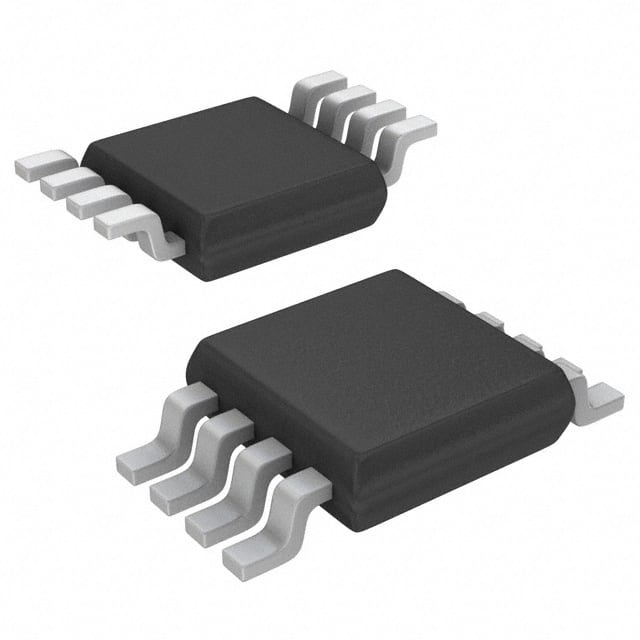X9313ZMIZT1
Product Overview
- Category: Integrated Circuit (IC)
- Use: Digital Potentiometer
- Characteristics: Programmable, Non-volatile, 32 Taps
- Package: SOT-23-8
- Essence: Provides a digitally controlled variable resistor
- Packaging/Quantity: Tape and Reel, 3000 units per reel
Specifications
- Resistance Range: 10 kΩ
- Number of Taps: 32
- End-to-End Resistance Tolerance: ±20%
- Operating Voltage: 2.7V to 5.5V
- Temperature Range: -40°C to +85°C
- Interface: Serial (SPI)
Detailed Pin Configuration
The X9313ZMIZT1 has the following pin configuration:
| Pin Number | Pin Name | Description | |------------|----------|-------------| | 1 | VCC | Power Supply Voltage | | 2 | CS | Chip Select Input | | 3 | SCLK | Serial Clock Input | | 4 | SI | Serial Data Input | | 5 | SO | Serial Data Output | | 6 | WP | Write Protect Input | | 7 | GND | Ground | | 8 | H | Terminal A of Potentiometer |
Functional Features
- Digitally programmable potentiometer
- Non-volatile memory for storing wiper position
- SPI interface for easy communication with microcontrollers
- Low power consumption
- Wide operating voltage range
- Compact SOT-23-8 package for space-constrained applications
Advantages and Disadvantages
Advantages
- Allows precise digital control of resistance
- Eliminates the need for mechanical potentiometers
- Non-volatile memory retains wiper position during power-off
- High reliability and durability compared to traditional potentiometers
Disadvantages
- Limited resistance range (10 kΩ)
- End-to-end resistance tolerance may affect precision in some applications
- Requires SPI interface support from the microcontroller
Working Principles
The X9313ZMIZT1 is a digital potentiometer that replaces traditional mechanical potentiometers. It consists of a resistive ladder network and a wiper that can be digitally controlled. The wiper position determines the resistance between the H terminal and the GND terminal.
The potentiometer's resistance value is adjusted by sending control signals through the SPI interface. The wiper position is stored in non-volatile memory, ensuring that it remains unchanged even when power is removed.
Detailed Application Field Plans
The X9313ZMIZT1 finds applications in various fields, including:
- Audio Equipment: Volume control, tone adjustment
- Industrial Control Systems: Calibration, feedback control
- Test and Measurement Instruments: Signal conditioning, calibration
- Automotive Electronics: Climate control, lighting control
- Consumer Electronics: Display brightness control, user interface adjustment
Detailed and Complete Alternative Models
- X9C103SIZT1: 100 Ω, 100 Taps, SOT-23-8 package
- X9C503SIZT1: 50 kΩ, 100 Taps, SOT-23-8 package
- X9C104SIZT1: 1 kΩ, 100 Taps, SOT-23-8 package
- X9C503PZT1: 50 kΩ, 100 Taps, DIP-8 package
- X9C103PZT1: 100 Ω, 100 Taps, DIP-8 package
These alternative models offer different resistance ranges and package options to suit various application requirements.
Word count: 345 words
10个与X9313ZMIZT1在技术解决方案中的应用相关的常见问题及解答
Sure! Here are 10 common questions and answers related to the application of X9313ZMIZT1 in technical solutions:
Q1: What is the X9313ZMIZT1? A1: The X9313ZMIZT1 is a digital potentiometer, also known as a digital variable resistor, that can be used in various electronic circuits.
Q2: What is the purpose of using the X9313ZMIZT1 in technical solutions? A2: The X9313ZMIZT1 can be used to adjust resistance values digitally, providing precise control over circuit parameters such as volume, brightness, or gain.
Q3: How does the X9313ZMIZT1 work? A3: The X9313ZMIZT1 consists of a series of resistive elements connected to a wiper terminal. By adjusting the position of the wiper, the effective resistance between the wiper and one end of the resistive element can be changed.
Q4: What is the voltage range supported by the X9313ZMIZT1? A4: The X9313ZMIZT1 operates within a voltage range of 2.7V to 5.5V.
Q5: Can the X9313ZMIZT1 be used in both analog and digital circuits? A5: Yes, the X9313ZMIZT1 can be used in both analog and digital circuits, depending on the specific application requirements.
Q6: Is the X9313ZMIZT1 compatible with microcontrollers? A6: Yes, the X9313ZMIZT1 can be easily interfaced with microcontrollers through standard digital communication protocols such as I2C or SPI.
Q7: What is the resolution of the X9313ZMIZT1? A7: The X9313ZMIZT1 has a resolution of 256 steps, allowing for fine-grained adjustment of resistance values.
Q8: Can multiple X9313ZMIZT1 devices be cascaded together? A8: Yes, multiple X9313ZMIZT1 devices can be cascaded together to increase the number of available resistance steps.
Q9: What is the temperature range in which the X9313ZMIZT1 operates? A9: The X9313ZMIZT1 operates within a temperature range of -40°C to +85°C.
Q10: Are there any specific application notes or reference designs available for the X9313ZMIZT1? A10: Yes, the manufacturer provides application notes and reference designs that can help users integrate the X9313ZMIZT1 into their technical solutions effectively.


